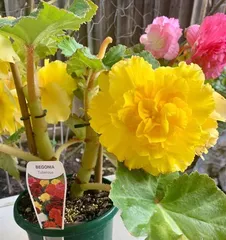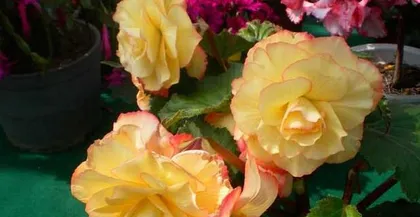Tuberous begonia is a beautiful flower with rich colors and full of vitality. Although they are usually planted in outdoor gardens, many people don't know that these flowers can also grow indoors. What should you pay attention to when growing tuberous begonias indoors? This article will introduce you in detail.

I. Basic Information of Tuberous Begonias
Tuberous begonia (Tulipa) is a plant native to Central Asia. They usually bloom in spring, with a flowering period of about two weeks. There are many varieties of tuberous begonias, including Dutch begonias, blue begonias, and wild begonias.
II. Are Tuberous Begonias Suitable for Indoor Cultivation?
Tuberous begonias are indeed suitable for indoor growth. However, before choosing tuberous begonias as an indoor green plant, you need to consider some factors. You need to ensure that the room has sufficient sunlight. In addition, the indoor temperature also needs to be maintained at an appropriate level.

III. How to Choose Suitable Tuberous Begonias?
When choosing tuberous begonias, you need to consider factors such as color, size, and shape. You can choose single-color or multi-color flowers, small or large tuberous begonias. In addition, you can also choose tuberous begonias with stems or without stems. Remember to choose healthy plants when purchasing tuberous begonias.
IV. Light Requirements for Tuberous Begonias
Tuberous begonias need sufficient light to grow and bloom. When cultivating indoors, you need to place the tuberous begonias near a window to ensure they receive full sunlight. If you don't have enough natural light, you can consider using artificial lights to supplement the light.
V. Water Requirements for Tuberous Begonias
Tuberous begonias need an appropriate amount of water to grow healthily. During indoor cultivation, you need to water regularly and ensure the soil is always moist. Please note that do not let the soil become too wet, otherwise it may cause the tubers to rot.

VI. Fertilizer Requirements for Tuberous Begonias
Tuberous begonias need an appropriate amount of fertilizer to grow healthily. During the growing period of tuberous begonias, you can fertilize the plant once every two weeks. Use fertilizer suitable for tuberous begonias and follow the instructions on the fertilizer packaging.
VII. Temperature Requirements for Tuberous Begonias
Tuberous begonias need suitable temperatures to grow healthily. In most cases, tuberous begonias need to grow within a temperature range of 15°C to 20°C. If the indoor temperature is too high or too low, it may affect the growth and flowering of tuberous begonias.
VIII. How to Keep Tuberous Begonias Healthy?
To keep tuberous begonias healthy, you need to regularly check the leaves and flowers of the plant. If you find any abnormal signs, such as withered flowers or yellowing leaves, you need to take timely action. In addition, you can also prune the leaves and flowers of the plant to promote growth.
IX. Pest and Disease Control for Tuberous Begonias
Tuberous begonias may be attacked by various pests and diseases, including aphids, mites, and whiteflies. To prevent pests and diseases, you need to check the plant regularly and take immediate action when problems are found. You can use pesticides or other chemicals to control pests and diseases.
X. Propagation Methods for Tuberous Begonias
Tuberous begonias can be propagated by tubers. During the growing period of tuberous begonias, you can separate the tubers and replant them in the soil. This can promote the propagation of tuberous begonias and increase their number.
XI. How to Provide Sufficient Humidity for Tuberous Begonias?
Tuberous begonias need a certain amount of humidity to grow healthily. You can place some water basins or sprayers around the plant to increase humidity. In addition, you can also plant tuberous begonias in soil with moisture-retaining functions.
XII. How to Provide Suitable Air Circulation for Tuberous Begonias?
Tuberous begonias need good air circulation to grow healthily. You can place the plant in a well-ventilated location and open the windows regularly to maintain air circulation. In addition, using an air purifier can also help improve air quality.
XIII. How to Handle the Flowering Period of Tuberous Begonias?
The flowering period of tuberous begonias is usually about two weeks. After the flowering period ends, you need to prune the flowers and leaves and stop fertilizing. Let the tuberous begonias rest for a period of time until the next growing season begins.
XIV. How to Solve Growth Problems of Tuberous Begonias?
If tuberous begonias have growth problems, such as yellowing leaves or slow growth, you need to take timely action. You may need to increase light, improve air circulation, adjust temperature, or change fertilization methods.
XV. Conclusion
Tuberous begonia is a beautiful plant that is not only suitable for planting in outdoor gardens but can also be cultivated indoors. As long as you pay attention to its needs for light, water, fertilizer, and temperature, you can successfully grow these flowers indoors.